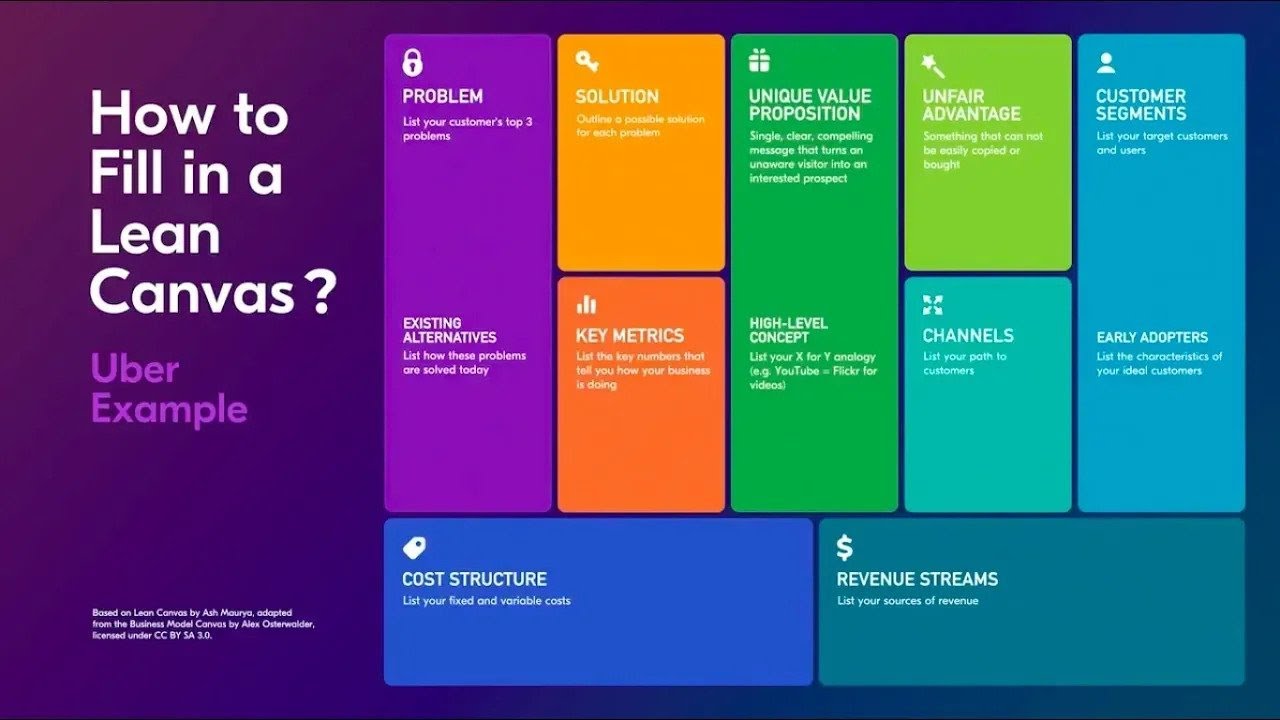In late 2011, I got accepted into a 6-month startup mentorship program called Startup Chile where I was introduced to lean startup methodology.
The lean startup methodology is a method of building a business by experimenting, testing, and iterating while developing products based on findings from your tests and feedback.
It’s a valuable process for building and launching products and services fast so you can test your assumptions in the marketplace rather than wasting 6 months or even years of your life on a business idea that isn’t going to work.

The easiest way to get started with the lean startup methodology is by creating a 1-page ADHD friendly business plan using the Business Model Canvas or Lean Canvas.
My personal preference is for the Lean Canvas and that’s the tool I use whenever I have a new business idea that I want to create an MVP (minimum viable product) to test it out. I use it for every new course, coaching or community offer that I launch.
Here’s the step-by-step process of creating your own 1-page ADHD friendly business plan with the Lean Canvas. If you want a handy free Notion template for the Lean Canvas, I recommend this one by Lean School.
1. Problem
Every great business solves an important problem. This is the foundation of your business so it’s important to get this right. Once you find a problem-market fit, you’ll be ready for high growth.
What is the problem that you solve with this business? List the top 3 problems.
2. Customer Segments
Here you would like to know who has this problem, is aware they have it and is motivated to buy a solution. You want to get clarity on who is your ideal “dream client” that you both would enjoy working with and can help them solve their problem.
This is very important as only a small percentage of people are ready to buy right away and the rest have to be nurtured through email, content or community to the point where they are ready to buy.
Who are your target customers? Quickly list their demographics and psychographics.
3. Unique Value Proposition:
A unique value proposition is a single, clear, compelling message that states why you are different and worth buying from.
If someone asks you what you do, you should have a scripted unique value proposition that explains what problem you solve, who you solve it for and what makes you different in under 30 seconds.
Here’s a UVP brand messaging template I use with my coaching clients: I help [dream client] achieve [result], so they can [what they desire] without [what they dislike].
4. Solution:
Here is where you clarify your unique mechanism or solution to the problem. It’s important to sell both the benefits and features of your product.
Here you want to get clarity about the step-by-step roadmap you will follow to work with clients to solve their problem.
What are the top 3 features of your solution?
5. Unfair Advantage:
What is your unfair advantage that can’t be easily copied or bought from others? It’s so easy to copy things these days with AI so it’s important to get clear why working with you is superior to the competition.
This is where it’s important to also do the Ikigai activity to identify your biggest passions and talents, which can be key differentiators that give you an unfair advantage. This is also important for building an ADHD friendly business because intrinsic motivators (passion, autonomy, mastery, purpose and belonging) are crucial for maintaining long-term motivation if you have ADHD.
What is your unfair advantage that can’t be easily copied with AI?
6. Revenue Streams:
Here you should list your different revenue streams. As an entrepreneur, it’s important to have a variety of revenue streams to diversify your business just like you diversify your investment portfolio.
Here are some good revenue stream metrics to estimate and clarify with experimentation and data: revenue model, estimated lifetime customer value, revenue goals for year 1 and gross margin target.
What are your revenue streams?
7. Cost Structure:
Here you make a list of estimates for important metrics that will be expenses and costs for your business.
Here are some good cost structure metrics and expenses to list: customer acquisition costs, business automation tools, hiring a virtual assistant, etc.
What is your cost structure?
8. Key Metrics:
Here you make a list of the key metrics or key performance indicators (KPIs) you will track.
Generally, a good place to start is with metrics like monthly recurring revenue, customer retention, net promoter score, churn rate and customer lifetime value.
What are the key metrics you will track to know you are on track?
9. Channels:
Here is where you list your main channels for reaching new customers. They can be SEO, referrals, social media, advertising, etc.
I’d recommend focusing on one primary channel initially but secondary channels are also okay to repurpose your content.
What are your key customer acquisition channels?
How To Use Your Completed Lean Canvas
I think of the Lean Canvas as a living document that I can constantly refine rather than a business plan that collects dust in a drawer somewhere. It can be completed it an hour and then constantly refined, making it an important foundation for building an ADHD friendly business.
In the Startup Chile program, we turned our Lean Canvases into short pitch decks we could use to deliver presentations to investors.
This is something I highly recommend doing for startup founders and anyone launching new businesses because pitching at a startup competition will give you valuable insight into the strengths and weaknesses of your business.
Joining a pitch competition is also a great way to meet and network with other like-minded entrepreneurs. I recommend looking up your local startup coworking or incubator space to find events in your area where you can share your business idea and pitch it investors to get valuable feedback.
This is especially important for entrepreneurs with ADHD. You community is your advantage and being surrounded by other successful entrepreneurs will massively increase your odds of success.
From my experience, the biggest part of success is just being around other highly creative and entrepreneurial people as this will upgrade your mindset and make you see more possibilities for growth.
As legendary business author Jim Rohn says, “You are the average of the 5 people you spend the most time with”. Make sure a couple of those people are also highly motivated entrepreneurs with ADHD.
Want a quick review of your Lean Canvas to get insight into how to improve your business model? Book a 15-minute Insight Call with me.
- 10 Tips, Tricks And Tools To Overcome ADHD Paralysis - March 19, 2025
- 10 Interesting Facts About Adult ADHD And Mental Health - March 18, 2025
- 15 Ways To Manage ADHD Without Meds By Biohacking Dopamine - February 14, 2025




